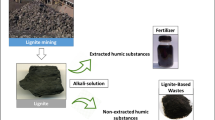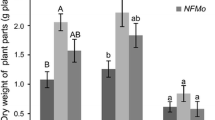Abstract
Previous research has identified Festuca cultivars as good candidates for use as phytostabilizers in metal-contaminated soils. Festuca species combine good metal sorption properties in root tissues with high metal tolerance and proven cultivation methods. These advantages may allow Festuca use in remediation projects where funding is unavailable to support more expensive soil remediation methods. This project expands previous research by combining fescue cultivars with various soil additives in laboratory tests, and identifying the best cultivar/soil amendment combination for field applications. Following laboratory analysis, field test plots will be monitored over two growing seasons to assess biomass production and metal stabilization effectiveness.
Access this chapter
Tax calculation will be finalised at checkout
Purchases are for personal use only
Preview
Unable to display preview. Download preview PDF.
Similar content being viewed by others
References
Baker, A., and Brooks, R., 1989, Terrestrial higher plants which hyperaccumulate metallic elements- a review of their distribution, ecology and phytochemistry, Biorecovery, 1: 81–126.
Blaylock, M., Salt, D., Dushenkov, S., Zakharova, O., Gussman, C., Kapulnik, Y., Ensley, B., and Raskin, I. 1997, Enhanced accumulation of Pb in Indian mustard by soil-applied chelating agents, Environmental Science And Technology, 31:860–865. Central Statistical Office, 2000, Basic Urban Statistics, Central Statistical Office, Warsaw, Poland.
Hubbard, C., 1984, Grasses: a guide to their structure, identification, uses and distribution in the British Isles, 3rd ed., revised by Hubbard, JCE, Penguin Books, Middlesex, UK.
Jørgensen, R., Consequences of using genetically modified plants for phytoremediation, Risø National Laboratory, DK-4000 Roskilde, Denmark.
Kahle, H. and Breckle, S., 1989, single and combined effects of lead and cadmium on young beech trees (Fagus sylvatica L.) Proceedings of the 14th International Meeting, International Union of Forestry Research Organizations (IUFRO), Part 2, Interlaken, Switzerland, October 5, 1988, pp. 442–444.
Krämer, U., Pickering, I., Prince, R., Raskin, I., and Salt, D., 2000, Subcellular localization and speciation of nickel in hyperaccumulator and non-accumulator Thlaspi species. Plant Physiol, 122(4):1343–1353.
Krämer, U., Cotter-Howells, J., Charnock, J., Baker, A., and Smith, J., 1996, Free histidine as a metal chelator in plants that accumulate nickel, Nature, 379:635–638.
Kucharski, R., 2000, Warynski site project, Presentation (July, 2003), Institute for Ecology of Industrial Areas, Katowice, Poland.
Kucharski, R., and Sas-Nowosielska, A., 2004a, Metallophytes: An integrated approach towards removal by plants of toxic metals from polluted soils, Publication pending.
Kucharski, R., Sas-Nowosielska, A., Malkowski, E., Pogrzeba, M., and Krzyzak, J., 2004b, A decision support system to quantify the cost/benefit relationship of the use of vegetation in the management of heavy metal polluted soils and dredged sediments, Phytodec, Internal Final Report in cooperation with US Department of Energy. Unpublished.
Lane, S., and Martin, E., 1982, An ultrastructural examination of lead localization in germinating seeds of Raphanus sativus, Zeitschrift Pflanzenphysiol. 107:33–40.
Mathys, W., 1977, The role of malate, oxalate, and mustard oil glucosides in the evolution of zinc-resistance in herbage plants, Physiol. Plant. 40:130–136.
Mossberg, B., Stenberg, L., and Ericsson, S., 1992, Den Nordiska Floran, Walhstrom and Widstrand, Turnhuot, Belgium, 1992.
Nowak, W., 2003, Clean coal fluidized-bed technology in Poland, Applied Energy, 74(3):405–413.
Pence, N., Larsen, P., Ebbs, S., Letham, D., Lasat, M., Garvin, D., Eide, D., Kochian, L., 2000, The molecular physiology of heavy metal transport in the Zn/Cd hyperaccumulator Thlaspi caerulescens, Plant Biology, 97(9):4956–4960.
Salt, D. and Kramer, U., 2000, Mechanisms of metal hyperaccumulation in plants,. Phytoremediation of Toxic Metals, John Wiley and Sons, Inc.
Tessier A., Campbell, P., and Bisson, M., 1979, Sequential extraction procedure for the speciation of paniculate trace metals, Analytical Chemistry, 51:844–851.
Hagemeyer, J., and Breckle, S., “Growth Under Trace Element Stress”, Waisel, Y., Amram, E., and Kafikafi, U., Eds., 1996, Plant Roots: the Hidden Half, 2nd ed., Mercel Dekker, Inc. New York, pp. 415–428.
Author information
Authors and Affiliations
Editor information
Editors and Affiliations
Rights and permissions
Copyright information
© 2006 Springer
About this paper
Cite this paper
KRZYŻAK, J., LANE, T., CZERWIŃSKA, A. (2006). THE POTENTIAL USE OF FESTUCA CULTIVARS AND LIGNITE FOR PHYTOSTABILIZATION OF HEAVY METAL POLLUTED SOILS. In: Simeonov, L., Chirila, E. (eds) Chemicals as Intentional and Accidental Global Environmental Threats. NATO Security through Science Series. Springer, Dordrecht. https://doi.org/10.1007/978-1-4020-5098-5_30
Download citation
DOI: https://doi.org/10.1007/978-1-4020-5098-5_30
Publisher Name: Springer, Dordrecht
Print ISBN: 978-1-4020-5096-1
Online ISBN: 978-1-4020-5098-5
eBook Packages: Chemistry and Materials ScienceChemistry and Material Science (R0)




